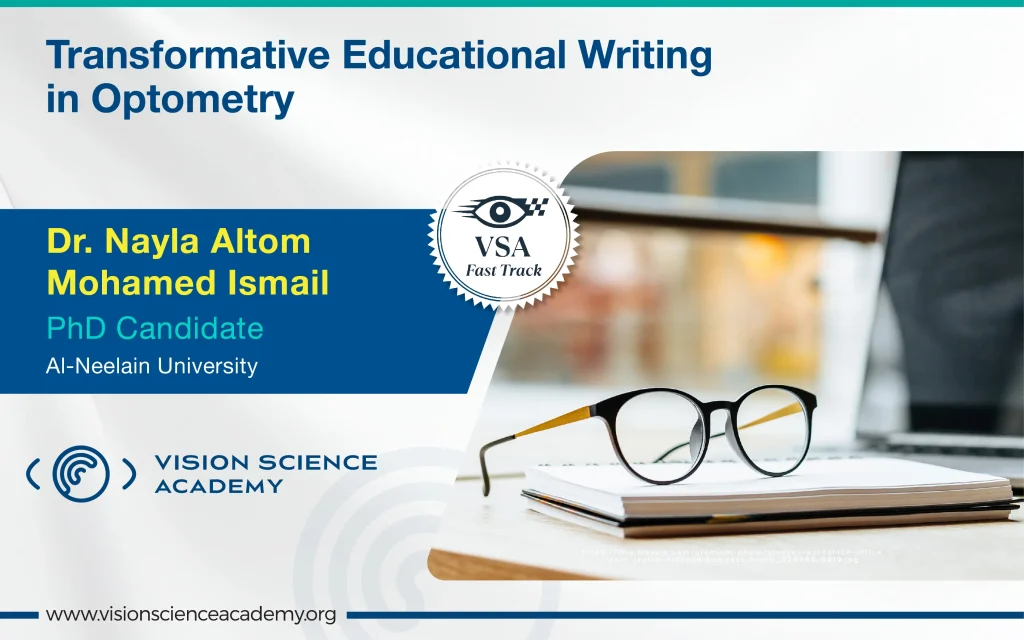Nayla Altom Mohamed Ismail, M.Optom.
PhD Candidate, Al-Neelain University, Sudan, Africa
In optometry, where vision significantly impacts life quality, a lack of practical, accessible references often leaves professionals and students in the dark. Many optometrists often seek guides not to memorise facts, but to make informed decisions for real patients. My journey started not as an author seeking recognition, but as a practitioner who identified and aimed to fill this gap.
Writing books helped clarify fragmented clinical realities, turning silent challenges into structured knowledge. It transformed scattered observations into coherent guidance, connecting theory with practice. This process was about building a bridge between clinical uncertainty and informed decision-making. Each chapter was written to solve real dilemmas encountered in underserved clinics and overwhelmed classrooms.
Over time, these works grew beyond the boundaries of personal effort and became trusted references in real-world settings. They filled a crucial void in optometric practice, offering accessible, experience-based solutions where standardised protocols were often lacking. (1,2)
In classrooms, they guided students navigating uncertainty. In clinics, they make informed decisions under pressure. They proved that clinical content written with urgency and purpose can drive both education and service quality. (1,2)
These books were not created in isolation—they were born from direct contact with patients, grounded in scientific training, and shaped by a deep understanding of the everyday needs of vision care. They became living tools—read, referenced, and applied where it mattered most. (4)
Clinical books rooted in field realities can influence not just students and professionals but institutions. When such content is adopted as reference material, it informs national guidelines, supports program development, and enhances the quality of primary eye care services. (1,2,3)
If you have walked the corridors of eye care through challenges, discoveries, and moments of impact, your insights matter. Your story might be someone else’s solution. The future of optometry depends on more voices, more experiences, and more written records of what works. (5)
But the story does not end here. It begins again every time a specialist chooses to document their experience, every time a student finds a spark between the lines, and every time a book dares to answer a question the world forgot to ask. Not all writing exists to answer. Some books are written to provoke, to stir thought rather than settle it.(5)
Sometimes, a book is not written with ink but with resilience, urgency, and the silent will to be effective. In the shadows of crisis, words can become lanterns, guiding both the writer and the reader toward clarity. (2)
Proficient writing in the field of eye care does not address everyone in the same tone. Instead, it masters the art of intellectual translation: simplifying for students without oversimplifying, deepening for researchers without overwhelming, and inspiring decision-makers without abstraction. It is writing that respects the diversity of its readers and elevates the message itself. (2)
Conclusion
Let us not wait for systems to change; let us write the change. Let us transform silence into sentences, fear into frameworks, and isolation into inspiration. Because sometimes a single book doesn’t just educate – it liberates. (4)
References:
- Ismail, N. A. M. (2024). Nilover–Pediatric Eye Care in Primary Health: Clinical Protocol. Translated by Ahmed Mustafa Element. ISBN: 978-603-05-5241-2. DLN: 1446/9548. RN: 202412118710174.
- Ismail, N. A. M. (2024). Nilover Clinical of Primary Eye Care. ISBN: 978-603-05-0897-6. DLN: 1445/22769. RN: 202405202245215.
- Ismail, N. A. M. (2024). AI-Driven Innovation: Redefining Optometry and Shaping the Future of Vision Standards. Published on Nilover Telegram Channel: https://t.me/ratgy/211?single
- Ismail, N. A. M. (2024). The Relation Between Sadness and Drop Vision. Published on Nilover Telegram Channel: https://t.me/ratgy/168
- Chung, Z. (n.d.). Close-up of hand writing on notebook over laptop [Photograph]. Pexels. https://www.pexels.com/photo/person-writing-on-a-notebook-over-a-laptop-5748837
